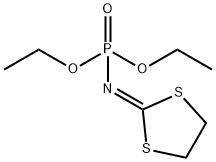Chemical Properties
Phosfolan is a solid organophosphorus insecticide in yellow colour or colourless appearance. Phosfolan is susceptible to formation of highly toxic and flammable phosphine gas in the presence of strong reducing agents such as hydrides. On heating, phosfolan gets decomposed and release/emits toxic gases and vapours, CO, NOx, SOx, and Pox. It does not undergo hazardous polymerisation reaction. Partial oxidation by oxidising agents may result in the release of toxic phosphorus oxides. Phosfolan is susceptible to formation of highly toxic and flammable phosphine gas in the presence of strong reducing agents such as hydrides. Partial oxidation by oxidising agents may result in the release of toxic phosphorus oxides. Phosfolan gets hydrolysed by alkalis.
Chemical Properties
Phosfolan is a colorless to yellow solid.
Uses
Phosfolan was identified and determined to be a residual pesticide in okra samples.
Definition
ChEBI: Phosfolan is a phosphoric ester.
General Description
Colorless to yellow solid. Used as an insecticide.
Air & Water Reactions
Hydrolyzed by alkalis. [EPA, 1998].
Reactivity Profile
Organophosphates, such as PHOSFOLAN, are susceptible to formation of highly toxic and flammable phosphine gas in the presence of strong reducing agents such as hydrides. Partial oxidation by oxidizing agents may result in the release of toxic phosphorus oxides.
Health Hazard
Similar to parathion. Death may result due to respiratory arrest as a result of paralysis of respiratory muscles and intense bronchoconstriction. Also considered a cholinesterase inhibitor.
Fire Hazard
(Non-Specific -- Organophosphorus Pesticide, n.o.s.) PHOSFOLAN may burn but does not ignite readily. Container may explode in heat of fire. When heated to decomposition, PHOSFOLAN emits very toxic fumes of oxides of phosphorus, sulfur, and nitrogen. Hydrolyzed by alkalies.
Safety Profile
Poison by ingestion and skin contact. An insecticide used against leaf-feeding larvae of cotton insect pests. When heated to decomposition it emits very toxic fumes of POx, SOx, and NOx. See also ESTERS
Potential Exposure
An organophosphate, A potential danger to those involved in the manufacture, formulation and application of this insecticide.
Shipping
UN3464 Organophosphorus compound, solid, toxic, n.o.s, Hazard Class: 6.1; Labels: 6.1-Poisonous materials, Technical Name Required. UN2783 Organophosphorus pesticides, solid, toxic, Hazard Class: 6.1; Labels: 6.1-Poisonous materials.
Incompatibilities
Organophosphates are susceptible to formation of highly toxic and flammable phosphine gas in the presence of strong reducing agents such as hydrideds and active metals. Partial oxidation by oxidizing agents may result in the release of toxic phosphorus oxides Incompatible with nitrates and water. May hydrolyze upon contact with water, steam and moisture, and produce toxic oxides of phosphorus, nitrogen, sulfur, and chlorine
Waste Disposal
Consult with environmental regulatory agencies for guidance on acceptable disposal practices. Generators of waste containing this contaminant (≥100 kg/mo) must conform with EPA regulations governing storage, transportation, treatment, and waste disposal. In accordance with 40CFR165, follow recommendations for the disposal of pesticides and pesticide containers. Must be disposed properly by following package label directions or by contacting your local or federal environmental control agency, or by contacting your regional EPA office.

